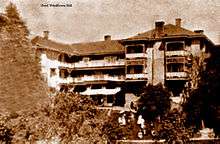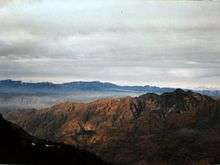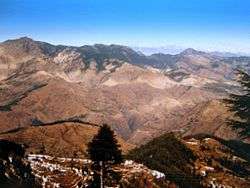Chharabra
| Chharabra | |
|---|---|
| Village | |
|
Himalayas view from Chharabra | |
 Chharabra  Chharabra Location in Himachal Pradesh, India | |
| Coordinates: 31°06′54″N 77°14′42″E / 31.115°N 77.245°ECoordinates: 31°06′54″N 77°14′42″E / 31.115°N 77.245°E | |
| Country |
|
| State | Himachal Pradesh |
| District | Shimla |
| Elevation | 2,514 m (8,248 ft) |
| Languages | |
| • Official | Hindi |
| Time zone | IST (UTC+5:30) |
| PIN | 171 012 |
Chharabra, a small village situated approximately 8250 feet (2514 m) above sea level, 13 km from Shimla, India, on National Highway 22 (Hindustan-Tibet Road), has summer retreat of President of India, summer residence of Governor of Punjab, a five star luxury hotel, a boarding school, and a helipad even though the population would be less than 500 people (including students of boarding school, staff of the President's Retreat and Governor's house and the hotel). The village is surrounded by evergreen pine forests, and has magnificent views of the Himalayas.
The Pir Panjal Range of the Himalayas at more than 19,000 feet (5,800 m) high, Deo Tibba at 19,687 feet (6,001 m), Chota Shali and Shali peaks, Bandar Poonch peak, Rakt Dhar at 20,100 feet (6,100 m), and Badrinath at 23,190 feet (7,070 m) are all visible from here.[1] Even though Chharabra is a separate village, it is officially considered part of Mashobra, which is a suburb of Shimla.
Chharabra is situated on top of mountains which are a major watershed. One side of Chharabra is part of the catchment area for the Yamuna river while the other side is part of the catchment area for the Satluj river. The entire area around Chharabra is densely forested and is part of Shimla Reserve Forest Sanctuary and Catchment Area.
Flora and fauna
Chharabra is part of Shimla Reserve Forest sanctuary and catchment area. The natural vegetation comprises pine, oak, cedar or Himalayan deodar, and rhododendron, as well as maple and horse chestnut. The wildlife consists of jackals, kakkar (barking deer), and the occasional leopard, as well as numerous bird species such as the Himalayan eagle, pheasants, chikor and partridges. During monsoons, many wild flower species, wild strawberries and other berries can be found in forest. Chharabra has good climate for apple cultivation and there are few apple orchards here. Cobra Plant is found in plentiful during monsoons. The Britishers introduced several trees and flowering plants notably Weeping Willows, Silver Oak, Chest Nut, etc. from other parts of the world that can be seen at Chharabra. The Retreat, Hem Kunj, Dukani, Kalyani House and Wild Flower Hall had weeping willows on their grounds.
Shimla Reserve Forest Sanctuary and Catchment Area
Shimla Reserve Forest Sanctuary and Catchment Area is situated adjacent to National Highway 22. It starts right after Dhalli and extends beyond Kufri. The area under this sanctuary is 951ha. The altitude ranges from 1,900 m to 2,620 m. The sanctuary is connected by a forest corridor to Chail Sanctuary in the south. This catchment which is the main water supply for Simla. Nine perennial streams flow from this area, the main ones being Churat Nala and God Ki Nala. The sanctuary is closed to visitors. There is one rest house inside, and three outside the sanctuary.[2]
Climate
Mean monthly maximum and minimum temperatures range from 8.6 C in January to 24.1 C in July and from 1.9 C to 15.7 C, respectively. Mean annual rainfall is 1600 mm. Annual precipitation is in excess of 1500 mm, over half of which falls during the summer monsoon.[2]
Chharabra has temperate climate with four distinct seasons. Summer months of April to June, Rainy season (monsoon) from July to August, Autumn from September to November and Winter from December to March.
Chharabra used to receive snowfall by end of November, but with global warming, there has been remarkable change in weather pattern here as well.
Places of interest
- The Retreat Building[3] is the official summer residence of the President of India. Entry to this building is by permission only. The President visits Mashobra at least once every year, and during this time his/her core office shifts to The Retreat at Chharabra. The building housing The Retreat is a purely wooden structure originally constructed in 1850. It has dajji wall construction, and a plinth area of 10,628 sq ft (987.4 m2).[4] The Retreat is the smallest of the Indian President's residences. After the Rashtrapati Niwas at Shimla was handed over to the Government of India in 1962 by the then President, Dr S. Radhakrishnan, in order to become an academic institute - the Indian Institute of Advanced Study, The Retreat was officially assigned to be the presidential mansion. The 16-room residence is surrounded by a 300-acre (1.2 km2) forest. The President stays at The Retreat for two weeks a year during the summer, but the building is mostly used by the Government of India to house foreign VIPs visiting Shimla. The property belongs to the former Raja of Koti, and has been given to the Government of India on a permanent lease.[5]
The building was originally constructed by the then Medical Superintendent of Simla whose name is not known (referred to merely as Mr. C____ in Simla Past and Present by Sir Edward Buck). The Retreat was taken on lease from Raja of Koti by Lord William Hay. During this period, the local population called it “Larty Sahib Ki Kothi” i.e. house of Mr. Larty as Lord William Hay was named by locals. The lease deed contained stipulations that (i) The two roads from Simla and Mashobra Village should, in interest of native population of Koti State, be open to Public; (2) No trees should be felled and (3) No cattle be slaughtered on the grounds. The lease of the Retreat was then taken by Sir William Mansfiled, Commander – in – Chief, and then By Sir Edward Buck in 1881. In 1896, Raja of Koti used his right of preemption and took the possession of the estate. Thereafter the Retreat was consigned it to Govt. on permanent lease by Raja of Koti. Earl of Elgin was the first Viceroy to have used The Retreat as Viceregal residence. Lord Elgin secured use of The Retreat for future viceroys and constantly spent his weekends at Retreat.[6]
- Hemkunj or Hem Kunj is the official summer residence of the Governor of Punjab, India. It was formerly known as Dane's Folly. It is situated on the road leading to The Retreat, between Wildflower Hall and The Retreat. The house was originally built by an Englishman called Mr Dane, who, believing that Shimla town would come up at this point, predicted that Shimla would come up on this side of the hill. However, as his prediction was proved wrong he named the house Dane's Folly.[7] A new building was constructed next to the Dane's Folly building, which is used as residence of Governor of Punjab. Dane's Folly and the new building both still exist. The entire property has now been renamed Hemkunj.

- Wildflower Hall Hotel[8] is a luxury hotel constructed on the site of the summer residence of Lord Kitchener of Khartoum. The original building of Wildflower Hall was located higher up than the present building. After the first building was burned, a second building was constructed at the present site. The first owner of Wildflower Hall was Mr. G.H.M. Batten, CS, private secretary to Earl Lytton (1876–1880). The Hall is also said to have been a favourite retreat of Lord Ripon. The most famous resident of Wildflower Hall was the Commander-in-Chief of the Indian Armed Forces, Lord Kitchener, who spent a considerable amount of money laying out the gardens, and planting trees and flowers. Immediately upon his arrival at Shimla, Lord Kitchener secured lease of the property from the then owner Mrs. Goldstien. In 1909, after Lord Kitchener returned to England, Wildflower Hall was sold to Mr. Robert Hotz and his wife. In 1925, after demolishing the old house, Mrs. Hotz erected a fine three-storey hotel. After Independence, the hotel was taken over by the Indian Government, and the Himachal Pradesh Tourism Development Corporation ran Wildflower Hall Hotel until 1993. On 4-5-1993 the building was razed to the ground by a fire caused by an electricity short circuit. After this event the Himachal Pradesh Government formed a joint venture with the Oberoi Hotel Group to rebuild Wildflower Hall as a luxury hotel.[9] The present building is the third building on the Wildflower Hall site.
- Kalyani Helipad: You can get magnificent view of the Himalayas, Shimla and the valley below from this point. This was originally the site of a two storied residential house called Dukani. Dukani was famous for its picnic grounds and terraced flower garden. The Striats Time reports of can competition called "Scents of Dukani" held here where the people were asked identify the smell of various flowers grown in the garden of Dukani.[10] It was built by Lt. Col. Thomas David Colyear (died 8 August 1875) of 7th Bengal Cavalry. Amongst its famous occupants were Sir John Woodburn, Lt. Governor of Bengal Sir George Robertsoe, Lt. Governor of Bengal Sir George Charles River, etc. Other owners of Dukani included H.B.Goad and Maharaja of Alwar.[11] This building was also owned by the late Sir Edward Buck, the author of "Simla, Past and Present".[12] The house was surrounded by an apple orchard. After independence the property was taken over by the Government of India. The building was used by the State Horticulture Department until 1986 when it was razed to make way for the helipad.
Educational institutions
- Himalayan International School[13] is a co-ed day and boarding school situated in summer palace of former Maharaja of Darbhanga called Kalyani House. The building was named after Maharani Kam Sundari (Kalyani) Singh, third wife of Maharaja of Darbhanga Kameshwar Singh. This school was founded by Major General Jagjit Singh (Retd.) and the main patron was Maharani Kalyani Singh of Darbhanga. Major General Jagjit Singh (Retd.) was also the first Chairman of the school. First principal of the school was Mrs. Indira Goswami.

Trekking around Chharabra
- A route leads from Chharabra to Kufri. This route starts from Hotel Wild Flower Hall and this route leads through thick forests to Kufri Cantonment.
- Second route is from Chharabra to Mashobra through apple orchards and pine forests. This is a very scenic route and one can have great view of Himalayas throughout the route. A metalled road leads to Presidential Retreat. Near the gate of Himalayan International School, a trail on right leads to Mashobra. Another route is to continue to the Presidential Retreat and a route leads to Mashobra from there.
- Thirds route leads from Chharabra to Dhalli. After reaching Himalayan International School, take the route to the left. This route leads through thick pine forests to Dhalli. There is a school for physically handicapped children on the way. This school is run by Government of Himachal Pradesh. A diversion from this route leads to Kalyani Helipad.
Shoppe =
- Himachali Traditional Shoppe
Hotels in Chharabra
- Hotel Wild Flower Hall
- Cedar Hill Lodge
- Hotel Madhuban
Restaurant and Dhabas
- Sher - E - Punjab
- Zevnar
- Roshan tea stall
Distance from Major Places in Shimla
- Distance from Shimla Railway Station - 12 km.
- Distance from Shimla Airport - 30 km.
- Distance from Shimla Interstate Bus Terminal - 11 km.
- Distance from Dhalli - 4.2 km.
- Distance from Kufri - 3 km.
- Distance from Wild Flower Hall Oberoi Leading world class small leading resort -'500'mts.
- Distance from Chandigarh - 130 km.
References
- ↑ Crossette, Barbara; Assistant, An; Teaching, Is (1981-01-04). "British India's Past Lives On in Simla". The New York Times. Retrieved December 5, 2007.
- 1 2 http://www.whereincity.com/india/himachal-pradesh/shimla.php accessed on Dec 24, 2007
- ↑ Without fear of favour An autobiography. Author: Joginder Singh
- ↑ "Official mention and description in Rashtrapati Bhavan site". Retrieved August 5, 2008.
- ↑ - accessed on Dec. 20, 2007
- ↑ Simla Past and Presnt by Sir Edward Buck
- ↑ "When Shimla was Simla" by D.K. Mukerjee; last accessed Aug. 5, 2008
- ↑ description and history; accessed on 5 Aug 2008
- ↑ accessed on 5 Aug 2008
- ↑ "The Straits Times, 21 November 1903". Newspapers. Retrieved 2013-08-27.
- ↑ Simla, Past and Present, by Sir Edward Buck at page 183.
- ↑ Simla, past and present [WorldCat.org]
- ↑ Home page
External links
| Wikimedia Commons has media related to Chharabra. |
